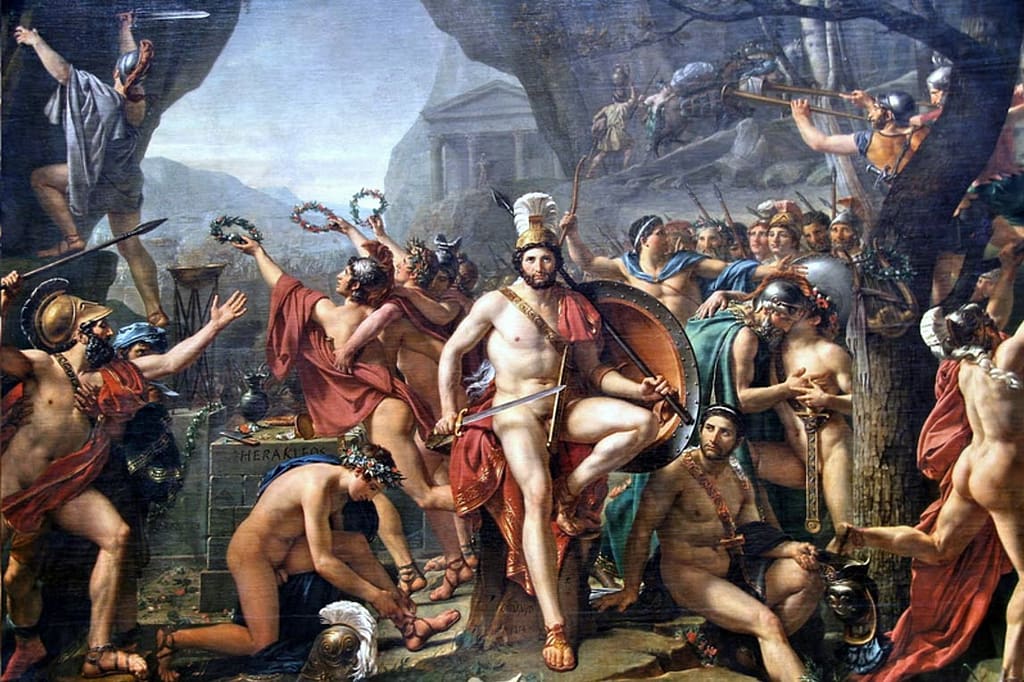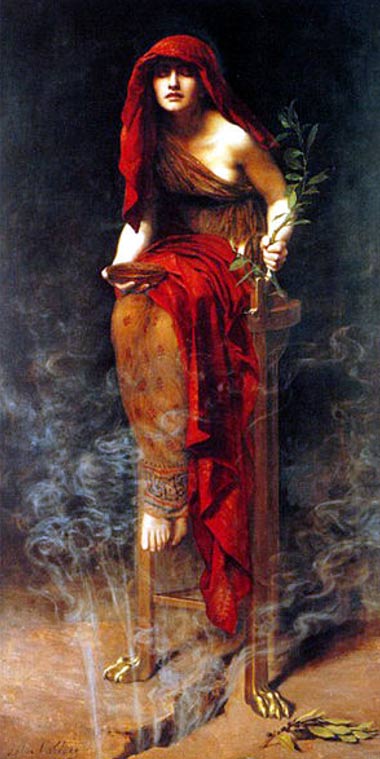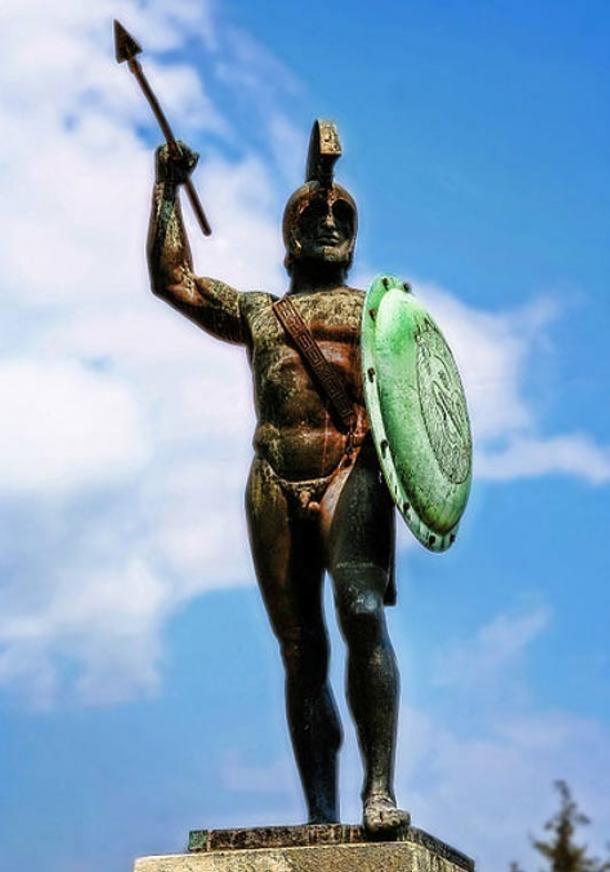Zack Snyder’s 2007 fantasy historical film, 300, has probably made the Battle of Thermopylae one of the most famous battles of the ancient world. It may be pointed out, though, that the film has more fantasy than history in it. Most people would be aware that the leader of the Greeks during the battle was Leonidas of Sparta. Yet, how much do we actually know about King Leonidas, and what happened during the Battle of Thermopylae?
According to ancient Greek historian Herodotus, Leonidas was the son of King Alexandridas and his first wife, an unnamed woman who was also the king’s niece. Leonidas, however, was not the first child, as his father’s second wife bore a son, Cleomenes. Soon after this, Alexandridas’ first wife bore a son as well, Dorieus, who was Leonidas’ elder brother. After Dorieus was born, she was pregnant with Leonidas, and he was followed by Cleombrotus, although Herodotus suggests that there was an account stating that Leonidas and Cleombrotus were twins.
Leonidas’ ascension to the throne of Sparta in 489 BC was, as described by Herodotus, ‘a result of an unforeseeable situation’. As the third son of Alexandridas, Leonidas’ chances of succeeding the throne were rather slim, and he had no designs on the kingship. Upon the death of Alexandridas, the Spartan throne went to Cleomenes. The new king, however, died without a male heir. Additionally, Dorieus lost his life on an expedition in Sicily. This meant that Leonidas was the eldest surviving son of Alexandridas, and he was the best person to succeed his bother. Moreover, Leonidas had married Cleomenes’ daughter, Gorgo.
Leonidas I of Sparta. (Wikimedia Commons)
The Persian Invasions
The new king Leonidas did not have an easy task ahead of him. Several years earlier, the Persians under king Darius I had invaded Greece, primarily in order to punish the city-states of Athens and Eretria, who had supported the cities of Ionia during their revolt against Persian rule. The invasion ended with the decisive Athenian victory at the Battle of Marathon in 490 BC, but it was not long before Darius began raising a huge new army with which he intended to return with full force. The threat of another Persian invasion threw the Greek states into alliance though many were still technically at war with each other.
Relief depicting the Battle of Marathon. (Military-history.org)
Darius was unable to launch an offensive in Greece immediately because of rebellions in other sectors of his empire and in 486 BC, while he was quelling these, he was killed in battle. His son, Xerxes, ascended to the throne. Determined to avenge his father’s defeat, Xerxes began to muster forces to once again invade Greece. By 480 BC, Xerxes had built up an enormous army of some one hundred and fifty thousand men and a navy of six hundred ships. He was now ready. In late August or early September of 480 BC, Xerxes launched his offensive upon Greece in what is now known as the Battle of Thermopylae.
The Battle of Thermopylae is the most famous battle of the Second Persian Invasion of Greece and one of the most famous battles in European ancient history. Unlike other battles, however, it was not a victory for the Greeks, but a defeat. Its fame is derived from being one of the most courageous last stands by the vastly outnumbered defending army of Greek city states led by King Leonidas of Sparta against the invading Persians under King Xerxes.
It took place in a narrow pass between the mountains of central Greece and the sea, called Thermopylae. This was a strategic move on the part of the Greeks. The narrowness of the pass negated the advantage the Persians had in numbers.
The site of the battle today: the road to the right is built on reclaimed land and approximates the 480 BC shoreline. (Wikimedia Commons)
Although the 300 Spartans were the most famous combatants on the Greek side, they were not the only Greeks present at the battle. One has to bear in mind that the Spartans had other Greek allies with them, including the Thespians, Thebans, soldiers from Mycaene and other Greek states. Herodotus gives the actual number of Peloponnesians at the battle alone as 3,100 or 4,000, and a grand total of over 5,000 Greeks. Modern estimates, however, suggest that the Greek forces numbered at around 20,000, which included the helots, retainers, and auxiliaries. The number of invading Persians is disputed at being between two hundred thousand to two and a half millions soldiers, though it is most likely closer to the former.
A Vision from the Oracle
Herodotus reports that before going into battle at Thermopylae, Leonidas consulted with the famous Oracle of Delphi, who issued a grim prophecy:
For you, inhabitants of wide-wayed Sparta,
Either your great and glorious city must be wasted by Persian men,
Or if not that, then the bound of Lacedaemon must mourn a dead king, from Heracles’’line.
The might of bulls or lions will not restrain him with opposing strength; for he has the might of Zeus.
I declare that he will not be restrained until he utterly tears apart one of these
‘Herodotus’. English translation by A. D. Godley. Cambridge. Harvard University Press. 1920
The Oracle’s prophecy convinced Leonidas that he would not survive the battle against the Persians. Keeping this in mind, he selected only men with living sons for his Spartan contingent, so that should they fall in battle, their sons could carry forward their family lines. En route to the battlefield, the Spartans recruited several forces from other Greek states.
The Oracle of Delphi by John Collier (Wikimedia Commons)
The Battle
The Battle of Thermopylae took place over three days. For the first two days, the Greeks were able to hold the front line, preventing the Persians from breaking through the narrow pass. Their longer thrusting spears and their heavy shields and body armor gave them a distinct advantage over the Persians, who were equipped with shorter javelin-type spears, wicker shields, and armor made only of woven linen.
The Greeks employed a phalanx formation, a rectangular mass military formation composed entirely of heavy infantry armed with spears, which was able to block the narrow pass with ease. The Spartans also used a clever strategy in which they pretended to retreat so that the Persians pursued them. They would then turn suddenly to attack. In the confusion they killed many of the enemy, who were caught off guard.
The ‘Immortals’, the elite troops of the Persian army, had not yet broken the Greek defense.
Men standing shoulder to shoulder in a Greek phalanx formation, based on sources from the Perseus Project. PublicDomain
Four Persian warriors of ‘The Immortals’, from the famous glazed brick friezes found in the Apadana (Darius the Great’s palace) in Susa (Wikimedia)
Betrayal
The tide turned when during the battle, a Malian (member of a Greek tribe) named Ephialtes, revealed a path that led the Persians around the mountain towards the back of the defending force. As darkness fell, Xerxes sent his best soldiers to take the path and come round behind the Greek army guarding the pass below.
When word reached Leonidas that their position had been compromised, he made a decision that continues to be the subject of immense analysis and debate – rather than abandon their position and withdraw to the south before the Persians arrived, Leonidas relieved the majority of his army, while ordering the 300 Spartans, 700 Thespians, and 400 Thebans to remain and fight.
It is unclear why he chose to stay, along with his small contingent of Spartans, Thespians and Thebans. Herodotus represents it as an act of deliberate courage and self-sacrifice carried out in accordance with the oracle’s prophecy. Other historians maintain that he remained in order to give the allied contingents, whom he dismissed (apart from the Thebans and Thespians), time to escape. In any case, there could only be one outcome – their slaughter.
The Fall of the Spartans
On the third and final day of the battle, the Persians had moved behind the Greek position and surrounded them in both directions. King Leonidas, as well as every last soldier that stood with him, were killed.
When Xerxes came to Leonidas’ corpse at the end of the battle, it is reported that he had his men cut off the head and stick it on a pole, something not customarily done by the Persians, who normally treated a valiant opponent with honor. This was taken by Herodotus as a sign that Leonidas was a great thorn in Xerxes’ side.
The decapitation of Leonidas is portrayed in the fictionalized movie ‘300 Rise of an Empire’
The Aftermath
The Battle of Thermophylae was undoubtedly a defeat for the Greeks, which allowed the Persians to continue their march into Greece. They eventually reached and sacked Athens. Nevertheless, the defeat at Thermopylae had turned Leonidas and the men under his command into martyrs. This boosted the morale of the surviving Greek soldiers, who went on to defeat the Persians in the Battles of Salamis and Plataea, which effectively ended the Second Persian Invasion. Moreover, the battle left a legacy that lasted for millennia, demonstrating the courage of a small number of warriors, who in the face of a much larger enemy, stood their ground until the bitter end.
A monument in Greece in honor of King Leonidas (Wikimedia Commons)
Featured image: Leonidas at Thermopylae, by Jacques-Louis David. 1814. Wikimedia Commons
References
academic.reed.edu, 2014. Thermopylae. [Online] Available at: http://academic.reed.edu/humanities/110tech/thermopylae.html
Frye, D., 2006. Greco-Persian Wars: Battle of Thermopylae. [Online] Available at: http://www.historynet.com/greco-persian-wars-battle-of-thermopylae.htm
Herodotus, The Histories, [Waterfield, R. (trans.), 1998. Herodotus’ The Histories. Oxford: Oxford University Press.]
Lendering, J., 2008. Thermopylae. [Online] Available at: http://www.livius.org/th/thermopylae/thermopylae2.html
The British Museum, 2014. The Battle of Thermopylae: Spartans v. Persians. [Online] Available at: http://www.ancientgreece.co.uk/war/story/sto_set.html
By Ḏḥwty
Source : ancient-origins









